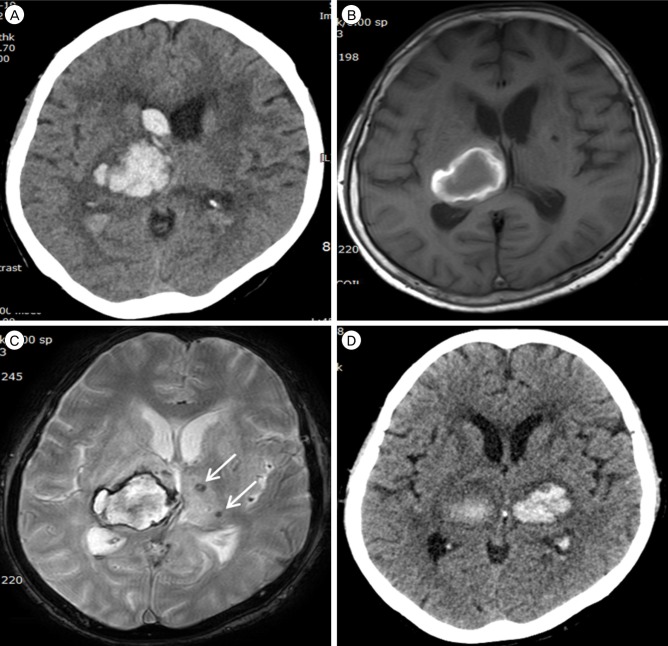J Cerebrovasc Endovasc Neurosurg.
2016 Jun;18(2):106-109. 10.7461/jcen.2016.18.2.106.
Delayed Consecutive Contralateral Thalamic Hemorrhage after Spontaneous Thalamic Hemorrhage
- Affiliations
-
- 1Department of Neurosurgery, Hallym University College of Medicine, Chuncheon, Korea. jjs6553@daum.net
- KMID: 2354884
- DOI: http://doi.org/10.7461/jcen.2016.18.2.106
Abstract
- Simultaneous or subsequent bilateral thalamic hemorrhagic events have ranged from 12 to 19 in prior reports, with a time lag between bilateral thalamic hemorrhage of up to two days. Herein, we report the first case of delayed (17 days) consecutive contralateral thalamic hemorrhage after spontaneous first thalamic hemorrhage. A 65-year-old female initially presented with a drowsy mentality with a left-side motor weakness (grade II/III). Brain computed tomography (CT) demonstrated right side thalamic and intraventricular hemorrhage. She regained alertness with mild residual motor weakness (grade III/IV) under medical management. Seventeen days later, a sudden and generalized tonic-clonic seizure developed. Brain CT scans revealed a new contralateral thalamic hemorrhage coincident with microbleeds. Neurologic status remained unchanged, consisting of a stuporous mentality with quadriparesis of grade II/II. We report the first case of delayed consecutive contralateral thalamic hemorrhage up to 17 days after first thalamic hemorrhage. The case highlights the need for close monitoring of patients with thalamic hemorrhage who experience microbleeds on the contralateral side, due to the possibility of delayed hemorrhage.
Keyword
MeSH Terms
Figure
Reference
-
1. Bae H, Jeong D, Doh J, Lee K, Yun I, Byun B. Recurrence of bleeding in patients with hypertensive intracerebral hemorrhage. Cerebrovasc Dis. 1999; Mar-Apr. 9(2):102–108. PMID: 9973653.
Article2. Chen ST, Chiang CY, Hsu CY, Lee TH, Tang LM. Recurrent hypertensive intracerebral hemorrhage. Acta Neurol Scand. 1995; 2. 91(2):128–132. PMID: 7785422.
Article3. Dromerick AW, Meschia JF, Kumar A, Hanlon RE. Simultaneous bilateral thalamic hemorrhages following the administration of intravenous tissue plasminogen activator. Arch Phys Med Rehabil. 1997; 1. 78(1):92–94. PMID: 9014966.
Article4. Fazekas F, Kleinert R, Roob G, Kleinert G, Kapeller P, Schmidt R, et al. Histopathologic analysis of foci of signal loss on gradient-echo T2*-weighted MR images in patients with spontaneous intracerebral hemorrhage: evidence of microangiopathy-related microbleeds. AJNR Am J Neuroradiol. 1999; 4. 20(4):637–642. PMID: 10319975.5. Furuta A, Ishii N, Nishihara Y, Horie A. Medullary arteries in aging and dementia. Stroke. 1991; 4. 22(4):442–446. PMID: 2024272.
Article6. Kono K, Terada T. Simultaneous bilateral hypertensive putaminal or thalamic hemorrhage: case report and systematic review of the literature. Turk Neurosurg. 2014; 24(3):434–437. PMID: 24848190.
Article7. Laiwattana D, Sangsawang B, Sangsawang N. Primary multiple simultaneous intracerebral hemorrhages between 1950 and 2013: analysis of data on age, sex and outcome. Cerebrovasc Dis Extra. 2014; 5. 4(2):102–114. PMID: 24932180.
Article8. Martinez-Ramirez S, Greenberg SM, Viswanathan A. Cerebral microbleeds: overview and implications in cognitive impairment. Alzheimers Res Ther. 2014; 6. 6(3):33. PMID: 24987468.
Article9. Nakagawa K, Serrador JM, LaRose SL, Sorond FA. Dynamic cerebral autoregulation after intracerebral hemorrhage: A case-control study. BMC Neurol. 011; 8. 11:108. PMID: 21884574.
Article10. Pantoni L. Cerebral small vessel disease: from pathogenesis and clinical characteristics to therapeutic challenges. Lancet Neurol. 2010; 7. 9(7):689–701. PMID: 20610345.
Article11. Perez J, Scherle C, Machado C. Subsequent bilateral thalamic haemorrhage. BMJ Case Rep. 2009; 2009.
Article12. Roob G, Lechner A, Schmidt R, Flooh E, Hartung HP, Fazekas F. Frequency and location of microbleeds in patients with primary intracerebral hemorrhage. Stroke. 2000; 11. 31(11):2665–2669. PMID: 11062292.
Article13. Sakaguchi J, Yonemura K, Hashimoto Y, Hirano T, Uchino M. Herpes simplex encephalitis originating from bilateral thalamic lesions with hemorrhagic component. Rinsho Shinkeigaku. 2005; 5. 45(5):368–371. PMID: 15960174.14. Stemer A, Ouyang B, Lee VH, Prabhakaran S. Prevalence and risk factors for multiple simultaneous intracerebral hemorrhages. Cerebrovasc Dis. 2010; 8. 30(3):302–307. PMID: 20664265.
Article15. Sueda Y, Naka H, Ohtsuki T, Kono T, Aoki S, Ohshita T, et al. Positional relationship between recurrent intracerebral hemorrhage/lacunar infarction and previously detected microbleeds. AJNR Am J Neuroradiol. 2010; 9. 31(8):1498–1503. PMID: 20448017.
Article16. Sunada I, Nakabayashi H, Matsusaka Y, Nishimura K, Yamamoto S. Simultaneous bilateral thalamic hemorrhage: case report. Radiat Med. 1999; Sep-Oct. 17(5):359–361. PMID: 10593286.17. Tanno H, Ono J, Suda S, Karasudani H, Yamakami I, Isobe K, et al. Simultaneous, multiple hypertensive intracerebral hematomas: report of 5 cases and review of literature. No Shinkei Geka. 1989; 3. 17(3):223–228. PMID: 2671770.18. Viswanathan A, Chabriat H. Cerebral microhemorrhage. Stroke. 2006; 2. 37(2):550–555. PMID: 16397165.
Article
- Full Text Links
- Actions
-
Cited
- CITED
-
- Close
- Share
- Similar articles
-
- Sudden Migration of a Thalamic Hemorrhage into the Ventricles
- Clinical Analysis of Spontaneous Thalamic Hemorrhage
- Acute Esotropia Secondary to Thalamic Hemorrhage
- Relationship of Hypertension and Hematoma Volume in Ganglio-thalamic Hemorrhages
- Two Cases of Acute Esotropia in Contralateral Thalamic Hemorrhage


